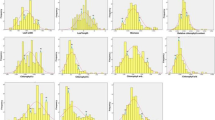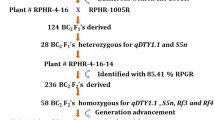Abstract
The identification of fertility restoration and genetic diversity of drought-tolerant breeding lines will be useful for the development of promising drought-tolerant rice hybrids. The extent of genetic variation of 204 drought-tolerant breeding lines based on the coefficient of parentage (COP) and test crossing with IR 58025A is studied. The linked molecular markers to Rf genes were screened on identified maintainers and restorers. The average value of COP for 204 drought-tolerant breeding lines was 0.21, which indicates genetic divergence in breeding lines. Four major groups comprising of 81 IR 64 type, 37 Apo type, 28 Vandana type, 6 WAB type and 52 others were identified. Out of 204 breeding lines, 37 (18.14%) maintainers, 55 (26.96%) partial maintainers, 63 (30.88%) partial restorers and 49 (24.02%) restorers were identified. Rf genes linked molecular markers RM7466 and RM443 on chr. 1; RM6344 on chr. 7 and RM6100, RM1108, RM216, RM171 and RM244 on chr. 10 were found associated with restorers and maintainers. These Rf genes linked molecular markers might be furthermore used in marker-assisted restorer selection in cytoplasmic male sterile-WA system from large source nurseries to avoid usual test crosses in the hybrid rice development programme. The identified restorer and maintainers may be used for the development of high-yielding drought-tolerant rice hybrids.


Similar content being viewed by others
Abbreviations
- WA:
-
Wild-abortive
- CMS:
-
Cytoplasmic male sterile
- Rf :
-
Restorer fertility gene
- QTL:
-
Quantitative trait loci
- SSR:
-
Simple sequence repeat
- COP:
-
Coefficient of parentage
- SMA:
-
Single marker analysis
References
Ahmadikhah A, Karlov GI, Nematzadeh GH, Ghasemi Bezdi K (2007) Inheritance of the fertility restoration and genotyping of rice lines at the restoring fertility (Rf) loci using molecular markers. Int J Plant Prod 1:13–21
Almanza MI, Khairallah M, Fox PN, Warburton ML (2003) Comparison of molecular markers and coefficients of parentage for the analysis of genetic diversity among spring bread wheat accessions. Euphytica 130:77–86
Balaji SP, Srikanth B, Hemanth KV, Subhakara RI, Vemireddy LR, Dharika N, Sundaram RM, Ramesha MS, Sambasiva RKRS, Viraktamath BC, Neeraja CN (2012) Fine mapping of Rf3 and Rf4 fertility restorer loci of WA-CMS of rice (Oryza sativa L.) and validation of the developed marker system for identification of restorer lines. Euphytica 187:421–435
Bazrkar L, Ali AJ, Babaeian NA, Ebadi AA, Allahgholipour M, Kazemitabar K, Nematzadeh G (2008) Tagging of four fertility restorer loci for wild abortive cytoplasmic male sterility system in rice (Oryza sativa L.) using microsatellite markers. Euphytica 164:669–677
Botstein D, White RL, Skolnick M, Davis RW (1980) Construction of a genetic linkage map in man using restriction fragment length polymorphisms. Am J Hum Genet 32:314–331
Campbell CL, Peterson PD, Griffith CS (1999) The formative years of plant pathology in the United States. APS Press, St Paul
Cox TS, Lookhart GL, Walker DE, Harrell LG, Albers LD, Rodgers DM (1985) Genetic relationships among hard red winter wheat cultivars as evaluated by pedigree analysis and gliadin polyacrylamide gel electrophoretic patterns. Crop Sci 25:1058–1063
Dellaporta SL, Wood J, Hicks JB (1983) A plant DNA minipreparation: version II. Plant Mol Biol Report 1:19–21
Evenson R, Herdt R, Hossain M (1996) Rice research in Asia: progress and priorities. IRRI, Los Baños, p 418 (CAB International, Oxon)
Fujii S, Toriyama K (2005) Molecular mapping of the fertility restorer gene for ms-CW-type cytoplasmic male sterility of rice. Theor Appl Genet 111:696–701
GovindaRaj K, Virmani SS (1989) Maintainer and restorers for different cytoplasmic male sterile systems. Intl Rice Res Newsl 14(5):7–8
Khera P, Singh AK, Priyadarshi R, Khandekar D, Allu RK, Hiremath C, Kumar R, Mohan R, Ulaganathan K, Shenoy V (2015) Genetic variability in trait-specific rice germplasm groups based on coefficient of parentage, SSR markers and fertility restoration. Plant Genet Resour 13(1):56–67
Khush GS (1997) Origin, dispersal, cultivation and variation of rice. Plant Mole Boil 35:25–34
Khush GS (2005) What it will take to feed 5.0 billion rice consumers by 2030. Plant Mol Biol 59:1–6
Kumari SL, Valarmathi G, Joseph T, Kankamany MT, Nayar NK (1997) Rice varieties of Kerala as restorers and maintainers for wild abortive cytoplasmic male sterile lines. Int Rice Res Newslett 22:11–12
Liu K, Muse SV (2005) Power marker: an integrated analysis environment for genetic marker analysis. Bioinformatics 21:2128–2129
Malarvizhi D, Thiyagarajan K, Manonmani S, Sankar PD (2003) Fertility restoration behavior of promising CMS lines in rice (Oryza sativa L.). Indian J Agric Res 37:259–263
Margat J, Frenken K, Faurès JM (2005) Key water resources statistics in aquastat. FAO’s Global information system on water and agriculture. IWG-Env, International Work Session on Water Statistics, Vienna
McLaren CG, Bruskiewich RM, Portugal AM, Cosico AB (2005) The international rice information system. A platform for meta-analysis of rice crop data. Plant Physiol 139:637–642
Messmer MM, Melchinger AE, Herrmann RG, Boppenmaier J (1993) Relationship among early European maize inbreds: II. Comparison of pedigree and RFLP data. Crop Sci 33:944–950
Mishra GP, Singh RK, Mohapatra T, Singh AK, Prabhu KV, Zaman FU, Sharma RK (2003) Molecular mapping of a gene for fertility restoration of wild abortive (WA) cytoplasmic male sterility using a basmati rice restorer line. J Plant Biochem Biotechnol 12:37–42
Nematzadeh GA, Kiani G (2010) Genetic analysis of fertility restoration genes for WA type cytoplasmic male sterility in Iranian restorer rice line DN-33-18. Afr J Biotech 9:6273–6277
Pande K, Ratho SN, Patnaik RN, Jachuck PJ (1990) Fertility restoration in cytoplasmic male sterile lines in rice. Oryza 27:232–238
Perrier X, Jacquemond-Collet JP (2006) Darwin software. Available at: http://darwin.cirad.fr/darwin/. Accessed 11 July 2020
Salgotra RK, Katoch PC, Kaushik RP (2002) Identification of restorers and maintainers for cytoplasmic genic male sterile lines of rice. Oryza 39:55–57
Sarial AK, Singh VP (2000) Identification of restorers and maintainers for developing basmati and non-basmati hybrids in rice (Oryza sativa). Plant Breed 119:243–247
Sarkar CKG, Fu Z, Singh AK (2002) Genetics of fertility restoration of WA based cytoplasmic male sterility system in rice (Oryza sativa L.) using basmati restorer lines. Indian J Genet 62(4):305–308
Sattari M, Kathiresa A, Gregorio GB, Virmani SS (2008) Comparative genetic analysis and molecular mapping of fertility restoration genes for WA, Dissi, and Gambiaca cytoplasmic male sterility systems in rice. Euphytica 160:305–315
Sheeba NK, Viraktamath BC, Sivaramakrishnan S, Gangashetti MG, Khera P, Sundaram RM (2009) Validation of molecular markers linked to fertility restorer gene(s) for WA-CMS lines of rice. Euphytica 167:217–227
Siddiq EA (1996) Current status and future outlook for hybrid rice technology in India. In: Ahmed MI, Viraktamath BC, Ramesha MS, Vijaya Kumar CHM (eds) Hybrid rice technology. Directorate of Rice Research, ICAR, Hyderabad, pp 1–27
Singh DK, Singh R (2000) Identification of parental lines for rice hybrid at Varanasi location. Oryza 20:201–205
Singh V, Panwar GS, Singh J (2013) Validation of SSR markers for fertility restorer gene in drought-tolerant advanced breeding lines of rice (Oryza sativa L.). Crop Res 45(3):66–73
Sohu VS, Phul PS (1995) Inheritance of fertility restoration of three sources of cytoplasmic male sterility in rice. J Genet Breed 49:93–96
UN (2020) World population day 11th July, United Nations. https://www.un.org/en/observances/world-population-day. Accessed 11 July 2020
Vanitha DJR, Shreedhara D, Kulkarni VV, Mahantashivayogayya K, Ghante VN (2020) Identification of maintainer and restorer lines for WA cytoplasmic male sterility in rice using pollen fertility and spikelet fertility. Int J Curr Microbiol App Sci 9(4):3125–3137
Viraktamath BC, Hariprasad AS, Ramesha MS, Ahmed I (2010) Hybrid rice in India. Technical Bulletin 47, Hyderabad
Virmani SS, Viraktamath BC, Casal CL, Toledo RS, Lopez MT, Manalo JO (1997) Hybrid rice breeding manual. International Rice Research Institute, Philippines
Wallace JS, Gregory PJ (2002) Water resources and their use in food production. Aquat Sci 64:363–375
Wang S, Lu Z (2006) Genetic diversity among parental lines of Indica hybrid rice (Oryza sativa L.) in China based on coefficient of parentage. Plant Breeding 125:606–612
Worldmeters (2020) Current world population. https://www.worldometers.info/world-population/. Accessed 11 July 2020
Zhou K, Zheng Y, Li H, Li R (1986) A preliminary study on fertile genotype of hybrid rice. J Sichuan Agric Univ 4:1–9
Acknowledgements
We are thankful to Barwale Foundation, Hyderabad for providing all the facilities for the execution of this research work and all the encouragement and support.
Funding
This study was funded by Barwale Foundation, Hyderabad, India.
Author information
Authors and Affiliations
Contributions
RP, VS and AKS were designed and conduct the experiment, recording of data and reviewed the manuscript. RP performed the molecular work, analysis of data and wrote the manuscript. AJ assisted to conduct experimental work, drafting and reviewing of the manuscript. All authors approved the final version of the manuscript.
Corresponding author
Ethics declarations
Conflict of interest
All the authors declare that they have no conflict of interest.
Additional information
Publisher's Note
Springer Nature remains neutral with regard to jurisdictional claims in published maps and institutional affiliations.
Supplementary Information
Below is the link to the electronic supplementary material.
Rights and permissions
About this article
Cite this article
Singh, V., Priyadarshi, R., Singh, A.K. et al. Study of fertility restoration and genetic diversity of drought-tolerant breeding lines for hybrid rice (Oryza sativa L.) development. J. Crop Sci. Biotechnol. 25, 51–61 (2022). https://doi.org/10.1007/s12892-021-00112-6
Accepted:
Published:
Issue Date:
DOI: https://doi.org/10.1007/s12892-021-00112-6




